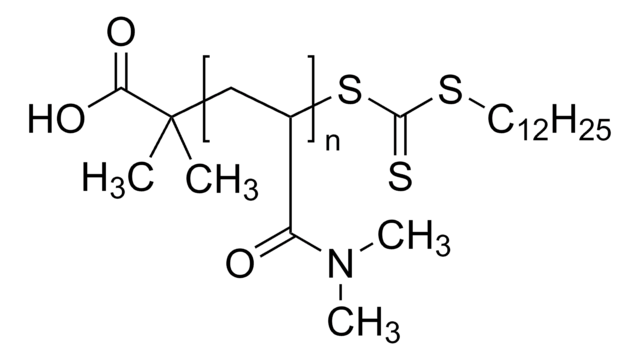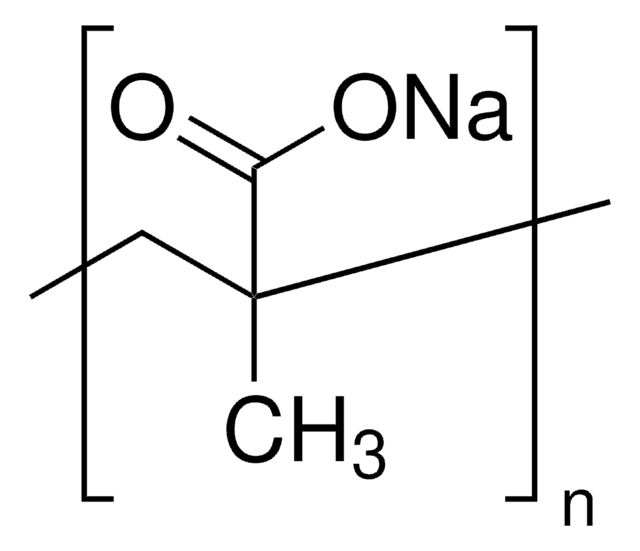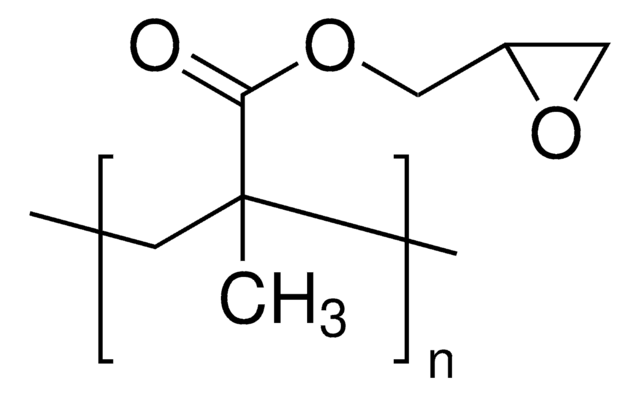529265
Poli(2-hidroxietil metacrilato)
average Mv 20,000
Sinônimo(s):
Poli(2-HEMA), Poli-HEMA
About This Item
Produtos recomendados
Formulário
powder
Nível de qualidade
peso molecular
average Mv 20,000
temperatura de transição
Tg 84.8 °C
densidade
1.15 g/mL at 25 °C (lit.)
cadeia de caracteres SMILES
CC(=C)C(=O)OCCO
InChI
1S/C6H10O3/c1-5(2)6(8)9-4-3-7/h7H,1,3-4H2,2H3
chave InChI
WOBHKFSMXKNTIM-UHFFFAOYSA-N
Procurando produtos similares? Visita Guia de comparação de produtos
Categorias relacionadas
Aplicação
- Hydrogen-bonds structure in poly(2-hydroxyethyl methacrylate) studied by temperature-dependent infrared spectroscopy: Investigates the hydrogen-bond structure in poly(2-hydroxyethyl methacrylate) (PHEMA) using temperature-dependent IR spectroscopy. (S Morita, 2014).
- Transparent and tough poly(2-hydroxyethyl methacrylate) hydrogels prepared in water/IL mixtures: Describes the development of tough and transparent PHEMA hydrogels for potential use in various biomedical applications. (Y Liu et al., 2020).
- Reduced cell attachment to poly(2-hydroxyethyl methacrylate)-coated ventricular catheters in vitro: Examines how PHEMA coatings can reduce cell attachment, which is beneficial for biomedical devices like catheters. (BW Hanak et al., 2018).
- Surface modification of poly(2-hydroxyethyl methacrylate) hydrogel for contact lens application: Studies modifications to PHEMA hydrogels to improve their suitability for contact lens applications. (M Kazemi Ashtiani, M Zandi, 2018).
forma física
Código de classe de armazenamento
11 - Combustible Solids
Classe de risco de água (WGK)
WGK 3
Ponto de fulgor (°F)
Not applicable
Ponto de fulgor (°C)
Not applicable
Equipamento de proteção individual
Eyeshields, Gloves, type N95 (US)
Escolha uma das versões mais recentes:
Já possui este produto?
Encontre a documentação dos produtos que você adquiriu recentemente na biblioteca de documentos.
Os clientes também visualizaram
Artigos
Professor Shrike Zhang (Harvard Medical School, USA) discusses advances in 3D-bioprinted tissue models for in vitro drug testing, reviews bioink selections, and provides application examples of 3D bioprinting in tissue model biofabrication.
Professor Shrike Zhang (Harvard Medical School, USA) discusses advances in 3D-bioprinted tissue models for in vitro drug testing, reviews bioink selections, and provides application examples of 3D bioprinting in tissue model biofabrication.
Self-assembled monolayers (SAMs) have attracted enormous interest for a wide variety of applications in micro- and nano-technology. In this article, we compare the benefits of three different classes of SAM systems (alkylthiolates on gold.
Biomaterials science involves the design and fabrication of smart materials for studying, directing, or mimicking biology. For successful integration of biomaterials in biological research, a meaningful understanding of biological systems is required.
Global Trade Item Number
| SKU | GTIN |
|---|---|
| 529265-25G | 4061833598955 |
| 529265-5G | 4061832558028 |
Nossa equipe de cientistas tem experiência em todas as áreas de pesquisa, incluindo Life Sciences, ciência de materiais, síntese química, cromatografia, química analítica e muitas outras.
Entre em contato com a assistência técnica










